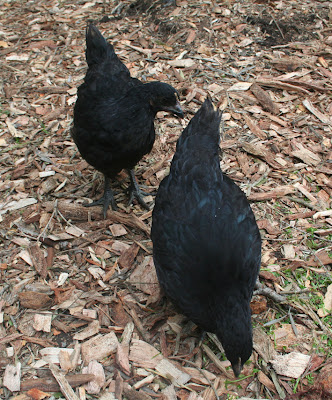Here are the kindergarten-hatched girls:
 |
| Two of the blacks, showing the nice shine on the feathers. When healthy, this sheen is typically a deep bottle green. I've heard that a violet or purple sheen is indicative of nutritional or health problems, though I haven't been able to verify that. However I'm quite happy with the growth and look of these birds. |
 |
| These are the three ISA browns (or ISA brown types) from the mix. Funny how they stick together! They're active, able bodied birds, but are notorious for being stroppy with any newcomers and being prone to peck and feather-pick. Given a good area to scratch in and decent feed they don't seem to peck or pick at one another, and interestingly while very tame the roosters don't tend to be aggressive toward the handler (unlike many other breeds). However it's true that they give newcomers a hard time, and their tameness seems to go hand-in-hand with a tendency to be bullies. I've found, however, that when they're crossed to something flightier or in fact to anything else, the offspring lose a lot of that ISA brown territoriality. |
 |
| A close-up of one of the blacks. These are typically a cross between layer australorps and rhode island reds (both commercial utility strains, not common backyard strains). They're a great forager like the ISA browns, but seem to have a slightly milder temperament. I've found them to be terrific layers and great pets. |
 |
| Four of the five blacks picking at the litter. Their male counterparts are still in the tractor and are larger than the girls, as well as having a much stronger hunger drive. While the girls are quite respectful, the males keep trying to eat my fingers as I stoop in to fill the feed trough. But they're great little chaps and I might even keep a couple of the black cockerels in case I lose a rooster to a goshawk. They'll always be useful to increase egg laying ability among purebreds and backyard crossbreds, and despite opinions to the contrary, I think they have been selected for hardiness. After all, while they're vaccinated to the hilt in commercial situations, they're also kept in massive sheds where sheer numbers create disease risks via stress. And given that they're on-sold to commercial egg farms, the breeders have to be sure that the offspring will survive the laying year. This contrasts with the variety of backyard breeding situations and approaches, some of which don't consider hardiness or longevity at all, and many of which don't cull or select for egg laying. Thus while there's a common generalisation that commercial birds will lay for a year before collapsing due to layer fatigue or reproductive disorders, when crossed to a rugged kind of backyard bird, the result can be selected for the best of both worlds (egg laying ability plus hardiness). |
Just some thoughts!
No comments:
Post a Comment